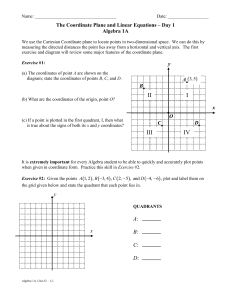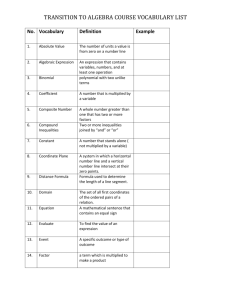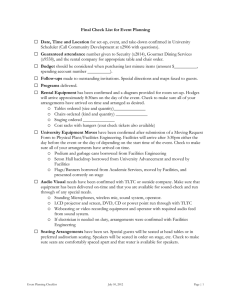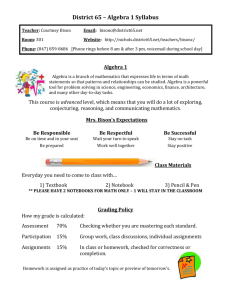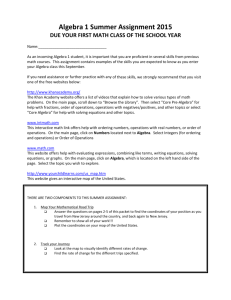1. Divide ÷ . Write the answer in simplest form (improper fraction or
advertisement
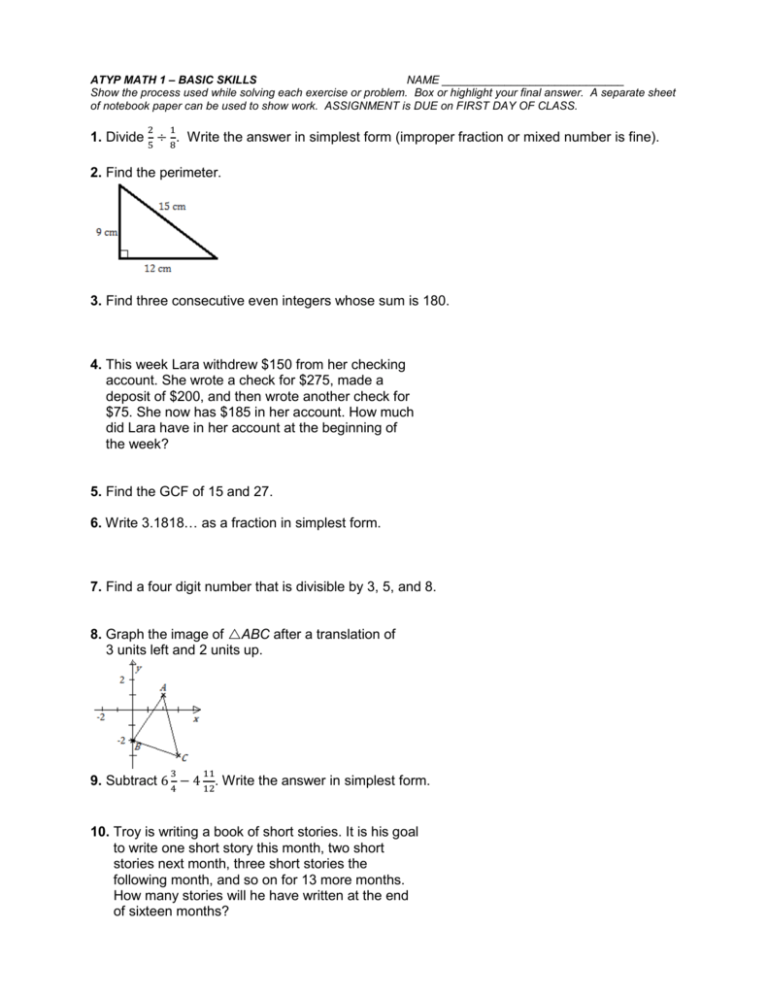
ATYP MATH 1 – BASIC SKILLS NAME _____________________________ Show the process used while solving each exercise or problem. Box or highlight your final answer. A separate sheet of notebook paper can be used to show work. ASSIGNMENT is DUE on FIRST DAY OF CLASS. 2 1 1. Divide 5 ÷ 8. Write the answer in simplest form (improper fraction or mixed number is fine). 2. Find the perimeter. 3. Find three consecutive even integers whose sum is 180. 4. This week Lara withdrew $150 from her checking account. She wrote a check for $275, made a deposit of $200, and then wrote another check for $75. She now has $185 in her account. How much did Lara have in her account at the beginning of the week? 5. Find the GCF of 15 and 27. 6. Write 3.1818… as a fraction in simplest form. 7. Find a four digit number that is divisible by 3, 5, and 8. 8. Graph the image of ABC after a translation of 3 units left and 2 units up. 3 11 9. Subtract 6 4 − 4 12. Write the answer in simplest form. 10. Troy is writing a book of short stories. It is his goal to write one short story this month, two short stories next month, three short stories the following month, and so on for 13 more months. How many stories will he have written at the end of sixteen months? 11. Find the volume of the following figure. 12. Write 3.04 as a percent. 13. Find the LCM of 15 and 27. 14. Graph the triangle with vertices A(-1, 3), B(-3, –2), C(0,-1). Then graph its image after a reflection across the y-axis. 2 1 15. Multiply 4 5 ∙ 5 6. Write the answer in simplest form. 16. When seating guests at a round table, two arrangements are considered the same if each person has the same neighbor to the left and to the right in each arrangement. Find the number of unique arrangements when seating 2, 3, and 4 guests at a round table. Use these results and the fact that 24 unique arrangements are possible when seating 5 guests to find the number of unique arrangements when seating 6 guests. 17. Write 3624 in expanded form using exponents (scientific notation). 18. There are 20 guests at a party. If each person shakes hands with every other person exactly once, how many total handshakes will occur? 19. Write 62 ∙ 33 in standard form (not scientific notation). 20. List the page numbers where Algebra I students can find the following useful information or skills in their Algebra I textbook~ a. Formulas of Geometry (page ____) b. Adding or subtracting Fractions (page ____) c. Translations (page ____) d. Illustrated Glossary (pages ____ to ____) e. “Extras Practice” and “Algebra Skills Handbook” (pages ____ to ____) *Complete the Chapter Test on page 50. SHOW ALL YOUR WORK. Turn in work and answers together with homework and answers from 1 to 20 above. Included on the back of this sheet are the instructions to access the Algebra I textbook online. Follow those instructions if you want to start your homework before orientation. Hold on to this piece of paper so you have online access to the books all year. ALWAYS prepare for your next class! When reading new sections to be discussed in class ~ Pay attention to what the book calls “New Vocabulary.” Some words or concepts may be familiar (highlighted in yellow). The definition or usage in Algebra may be a little different than areas outside of mathematics or science. Think about an example of how the concepts can be demonstrated in an equation or a sample (for example, the Venn Diagram on page 18 shows a few examples in the sets of whole, rational, and irrational numbers; a counterexample for the false statement “every multiple of 3 is odd” could be “6”) Read through the introduction of each new section. Study the processes in each example. Come to class with questions about what you’ve read or about specific problems in homework. After the school year starts, you will want to exchange phone numbers so you can also ask classmates to study groups or to work together over the phone. ALWAYS …Bring homework solutions to class along with any calculations done (show your work!). Put your name on the top of the stapled, in-order-by-section pages; name and due date on first page, initials thereafter. ****BE READY to discuss the following ON THE FIRST DAY of Algebra class: 1. Explain why the rules for the order of operations are necessary. [Section 1-2] 2. Sometimes called the Cartesian Plane (page 24-25), the coordinate plane can be divided into four quadrants. Any points on a coordinate plane can be located by its ordered pair. Read the review about “Graphing on the Coordinate Plane” and pay attention to how to use the coordinates to find the midpoint of a line segment with given endpoints. 3. How does a domain and range, independent and dependent variables, and x-values and y-values relate in the graph of a function? Group these six terms into two related lists. Explain your choices. [Section 1-4] 4. Find an example of a scatter plot in a newspaper (USA Today often has them) or search for an example on-line to copy and bring to class. We will put the examples on the board and compare positive, negative, or no correlations and try to create a trend line (if there’s not already one on your scatter plot). [Section 1-5] 5. Most of you have heard of mean, median, and mode for a set of data. When should the mean be used to describe data and when should median be used? What measure(s) are easy to find from a stem-and-leaf plot? [Section 1-6] a1-myer

